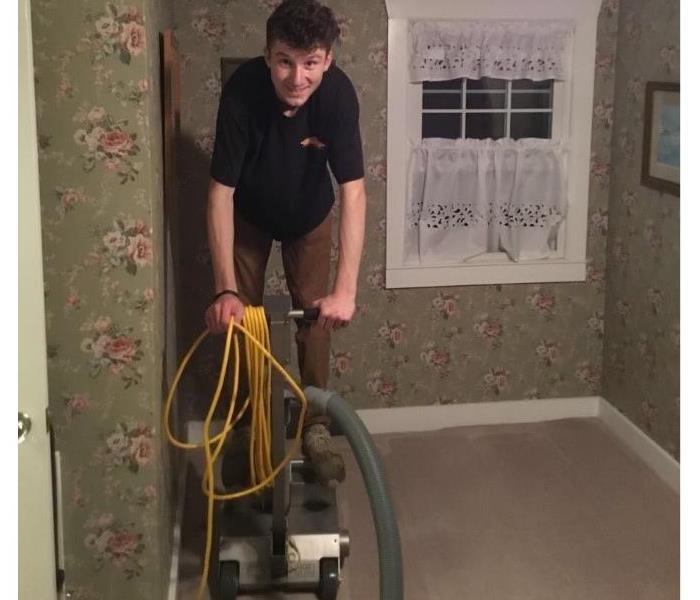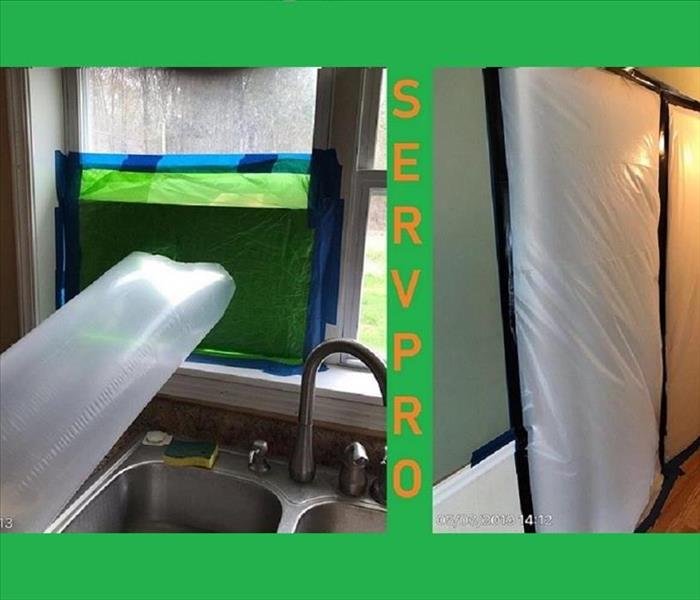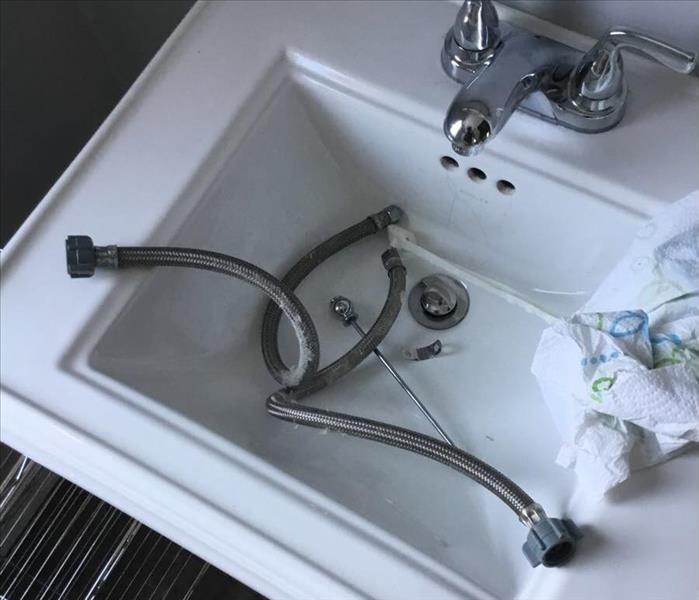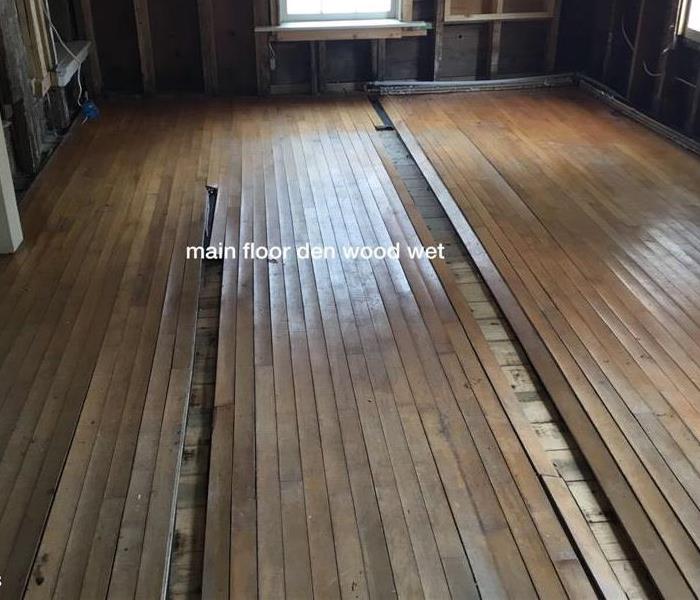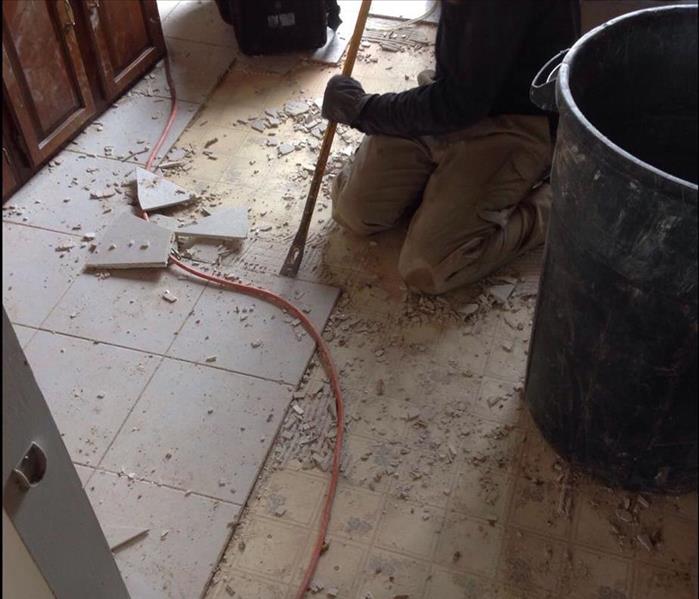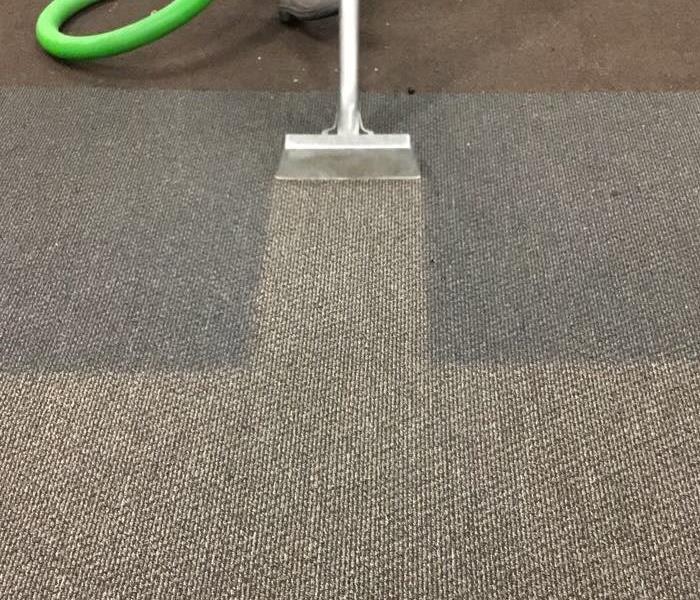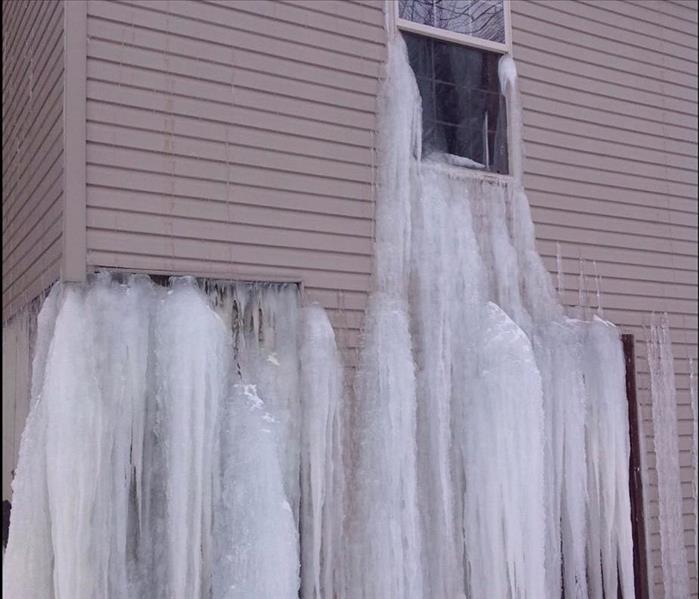Recent Water Damage Posts
Oh no my basement flooded! What do I do?
8/16/2022 (Permalink)
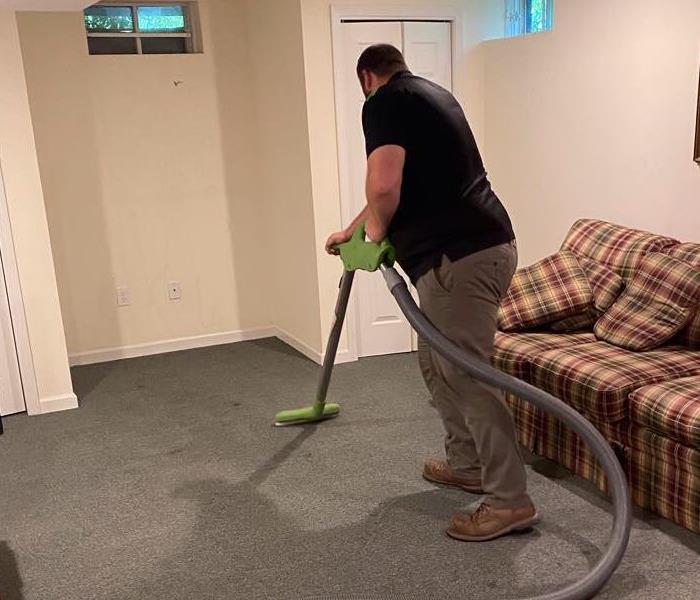 Call us at 518-677-3444!
Call us at 518-677-3444!
What to do When Your Basement Floods
When a basement floods it is a stressful and confusing time. There are several different reasons basements can flood, a broken water pipe, heavy rainfall, or even a sump pump failure. Fortunately, here at SERVPRO of North Rensselaer/South Washington Counties we have been able to help families with flooded basements all around our local area and are ready to help you! Here are some important steps to take when dealing with a flooded basement:
- Turn off your electricity. This is the first step you want to take as soon as you can safely navigate to the breaker box. Appliances or wires may be in water so there is a good chance there is an electrical current traveling through standing water. This can be deadly! You would want to contact an electrician or electrical company if you are unable to turn it off safely.
- Find/Stop the source of the flood. If you discover the flood is plumbing related you will want to turn off your homes main water valve. If you discover it is rainwater that is flooding your home you will want to use sand bags or flood bags to create a barrier.
- Remove the water. You can use a shop vac, mopping, or blotting to do this depending on the severity. However, the more water you can pick up the better!
- Remove affected materials. You want to dispose of flooded carpeting or padding that is unsalvageable. Other porous items such as wooden furniture or sofas need drying as soon as possible to salvage them!
- Did you know that mold can start to develop withing 24 hours of introduction to water? It is crucial to dry and disinfect the area properly in order to keep mold and bacteria from growing and spreading.
If your home suffers a water damage from a flooded basement, you want to check your insurance coverage to see what is covered. We here at SERVPRO of North Rensselaer/ South Washington Counties have years of experience and the resources to help with all your water damage needs. And we are prepared to get your home back to pre-flood conditions, “Like it never even happened.”
Did you know there was more than 1 type of water?
5/24/2022 (Permalink)
Water that goes into your home or comes from your home has what we call a “category’. If you have an emergency at your home, water needs to be treated correctly to be safe. You never know what is either in your water of what the water has passed through to create contamination.
Below there is explanations of the main types of water damage and could help you identify the problem quickly if it ever happens to you.
Category One: Clear Water
This is the cleanest water. This is also the most non-toxic form of water damage. It’s possible that this water can come directly from a tap. It is also unlikely to cause you any harm even if you are exposed to it for some time. Unfortunately, although fairly safe, even clean flooding can cause electrical and structural faults. Clean eater floods can come from things like a broken water supply line, appliance malfunctions, and sink or tub overflow with no contaminants. Once clean water leaves the exit point, it might not remain clean after contacting other surfaces or materials. Although considered the “safest” of the categories it can become a category 2 or 3 if left untreated.
Category Two: Gray Water
Category two, considered gray water is a little but more serious and does require a faster removal process. This water needs to be removed faster, because it may contain potentially unsafe levels of chemicals, microorganisms, or dirt. Some examples of Category 2 water can include but are not limited to: overflow from dishwashers or washing machines; overflows from toilet bowls with urine; seepage due to hydrostatic pressure and broke aquariums. If a category 2 is left untreated it can quickly become a category 3.
Category Three: Black Water
Water considered a Category three is grossly contaminated water and can contain pathogenic, toxigenic or other harmful agents. Sewage, toilet backflows from beyond the trap; flooding from seawater, rivers or streams, ground surface water, or other contaminated water entering the indoor environment are some of the types of Category 3 waters.
The team here at SERVPRO of North Rensselaer and South Washington counites is highly skilled in the safe handling of the different categories of water. We take all protective measures to eliminate the risk of sickness. If you are experiencing a water loss in your home call us 518-677-3444 24 hours a day, 7 days a week!
Information needed to report a Water Loss
4/7/2022 (Permalink)
Large or small, SERVPRO of North Rensselear/South Washington Counties is available for water emergencies 24 hours a day 7 days a week. Immediate action is extremely important when it comes to water damage. Any delay even just a few hours can greatly increase the severity of the water damage.
When calling to report a water emergency our office staff will as you several questions. These questions will help determine the equipment and resources that we need to bring, and how many of our trained SERVPRO professionals may be needed.
Some of the questions are as followed:
- Your name and contact information
- Your insurance information (if applicable)
- When did the flooding or water damage occur
- Is there electricity available (on-site?)
- The address of the water-damaged home or business
- What caused the water damage (if known?)
SERVPRO of North Rensselear/South Washington Counties specializes in the cleanup and restoration of residential and commercial property after damage has occurred. From the initial and ongoing training, to regular IICRC-industry certification, you can rest assured out staff is equipped with the knowledge to restore your property. Call today (518) 677-3444!
Did a Pipe Burst cause water damage to your home?
3/9/2022 (Permalink)
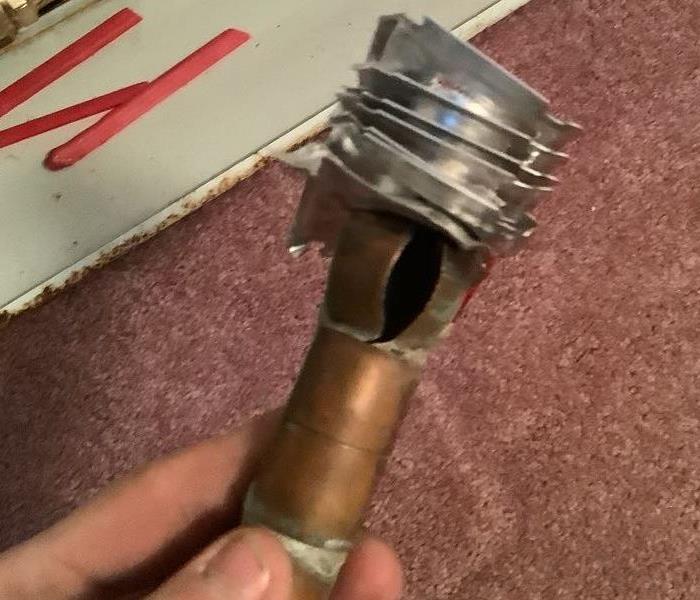 Broken Pipe causing water damage
Broken Pipe causing water damage
During the coldest time of the year pipe bursts are common causes of water coming into your home. In a short time, a large amount of water can enter the home and have an impact on the contents inside such as furniture, carpets, and bookcases. Initially, the first thing to be done is to have the water extracted. Once extraction is completed, there is a good chance your carpet can be restored as generally water coming from pipes is clean water. There are a few different methods that SERVPRO of North Rensselear/South Washington Counties can do to restore your carpets to preloss conditions.
- Deluxe Precondition and Rinse helps in the restoration of deeply soiled areas
- Showcase Premier Cleaning is the most thorough cleaning method in the industry
When it comes to other contents of your home such as furniture, window drapes, and bookcases our water damage restoration experts are often able to mitigate any water damage that affects certain types of furniture such as upholstered and wood furniture and drapes. Using equipment like air movers and dehumidifiers they are able to dry the contents and carpets.
Our Crews here at SERVPRO of North Rensselear/South Washington Counties understand how important immediate water extraction is to restore your home quickly. Contact us today for service that responds 24 hours a day 7 days a week! (518) 677-3444
It's that time of year where the pipes may freeze.
12/2/2021 (Permalink)
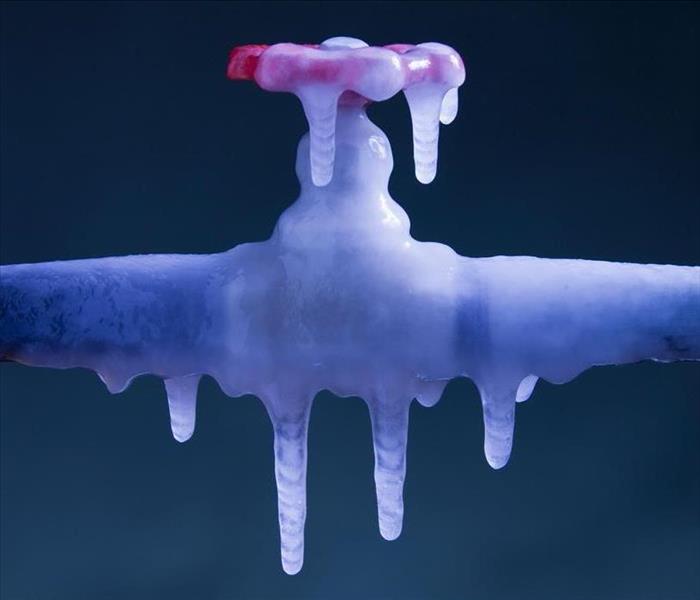 Give us a call to clean up your water loss. 518-677-3444
Give us a call to clean up your water loss. 518-677-3444
SERVPRO of North Rensselaer/South Washington Counties gets flooded with calls each winter due to pipes bursting. Sometimes they are big jobs and sometimes they are small jobs. One thing, however, that all these jobs have is insulated pipes. Here are some tips on making sure the pipes don’t burst.
- The use of pipe insulation- Pipe insulation is used to prevent metal and rigid plastic water filled lines from freezing.
- Different Types of insulation include: Mineral wool, glass wool, flexible elastomeric foams, rigid foam, polyethylene, cellular glass, aerogel.
- Opening cabinets- Pipes can be located on exterior walls. Watching out for signs that the weather is going to be colder than usual, will help determine whether or not you should open up your cabinet doors so that the heat from the inside the house can help keep the warmth on the pipes.
- Different areas that a pipe could be on an exteriors wall. Kitchen sinks, washing machines, and bathroom sinks.
- Turning on the faucet-When the temperature hovers around -20 degrees, its time to let a least one faucet drip. Be sure to pay close attention to waters pipes because temperatures in this unheated interior spaces usually mimic outdoor temperatures.
- Different area in the house that could be affected in the winter months are, attics, garages, basements, and crawl spaces.
If you have frozen pipes and they burst and affect your home. Give SERVPRO a call. 518-677-3444
Pipes Frozen? No Thank you! Tips to Prevent Frozen Pipes This Winter!
12/1/2021 (Permalink)
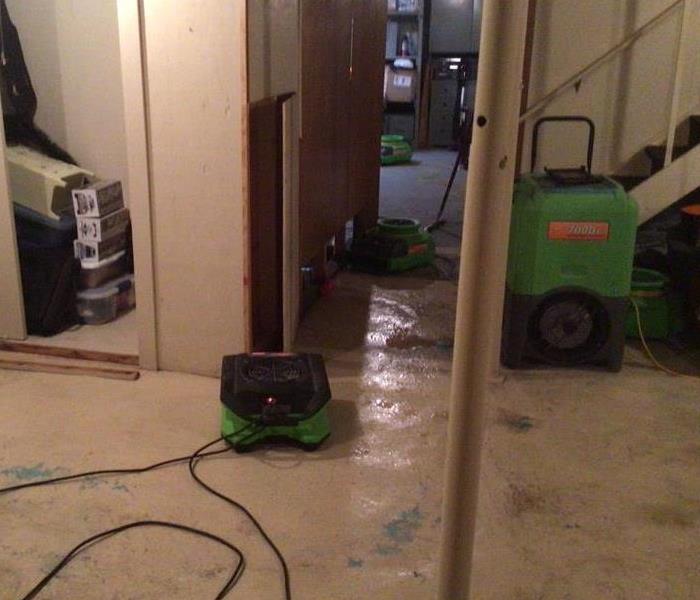 Give us a call at 518-677-3444!
Give us a call at 518-677-3444!
With fall on its way out we are moving into winter months! And with that comes freezing temperatures! One of the most common causes of water damages in the winter months is when pipes freeze. When pipes freeze they expand which causes them to burst resulting in a water damage in your home. We here at SERVPRO of North Rensselaer/ South Washington Counties are here to help you if you or your business experience a water damage from frozen pipes this winter! A water damage in your home is no fun so here are a few tips to help prevent your pipes from freezing this winter!
- Adjusting your thermostat- keeping your thermostat the same temperature during both the evening and day reduces risk of pipes freezing
- Going away- if you are leaving your home for an extended period, leave your heat on and set the temperature to 55 degrees Fahrenheit.
- House Sitting- as a neighbor to check your house daily to ensure it is warm enough and pipes have not frozen.
- Garage- keep your garage door closed to keep cold air out!
- Insulation- insulate all exposed pipes properly.
- Faucet- Let your faucet drip, moving water is less likely to freeze!
So if your pipes freeze at your home or business and you experience a water damage please call us at 518-677-3444. We are available 24/7 365 days a year and are always happy to help!
What to do When Your Basement Floods
8/6/2021 (Permalink)
When a basement floods it is a stressful and confusing time. There are several different reasons basements can flood, a broken water pipe, heavy rainfall, or even a sump pump failure. Fortunately, here at SERVPRO of North Rensselaer/South Washington Counties we have been able to help families with flooded basements all around our local area and are ready to help you! Here are some important steps to take when dealing with a flooded basement:
- Turn off your electricity. This is the first step you want to take as soon as you can safely navigate to the breaker box. Appliances or wires may be in water so there is a good chance there is an electrical current traveling through standing water. This can be deadly! You would want to contact an electrician or electrical company if you are unable to turn it off safely.
- Find/Stop the source of the flood. If you discover the flood is plumbing related you will want to turn off your homes main water valve. If you discover it is rainwater that is flooding your home you will want to use sand bags or flood bags to create a barrier.
- Remove the water. You can use a shop vac, mopping, or blotting to do this depending on the severity. However, the more water you can pick up the better!
- Remove affected materials. You want to dispose of flooded carpeting or padding that is unsalvageable. Other porous items such as wooden furniture or sofas need drying as soon as possible to salvage them!
- Did you know that mold can start to develop within 24 hours of introduction to water? It is crucial to dry and disinfect the area properly in order to keep mold and bacteria from growing and spreading.
If your home suffers a water damage from a flooded basement, you want to check your insurance coverage to see what is covered. We here at SERVPRO of North Rensselaer/ South Washington Counties have years of experience and the resources to help with all your water damage needs. And we are prepared to get your home back to pre-flood conditions, “Like it never even happened.”
Summer Vacation Plans? Protect Your Home From Water Damage While You Are Away!
5/13/2021 (Permalink)
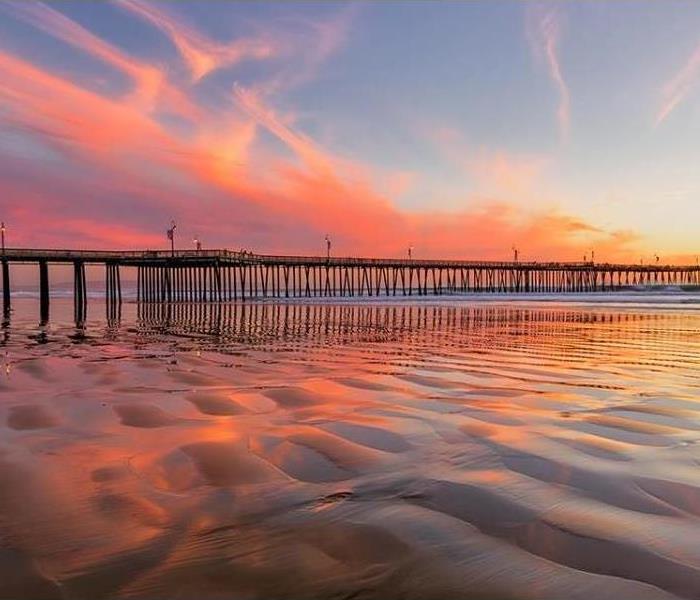 Give us a call for all your water, fire, or mold needs. 518-677-3444
Give us a call for all your water, fire, or mold needs. 518-677-3444
Summer Vacation Plans? Protect Your Home From Water Damage While You Are Away!
Summer 2021 officially kicks off June 21st, 2021! And with summer usually comes a vacation. We all could use a vacation and the last thing you want to worry about on vacation is a water damage in your home when you return. One of the most common causes of home water damage during the summer is when a family leaves to go on vacation. We leave our homes empty for days, weeks, and some people even months and the tiniest of leaks left unchecked can cause a substantial amount of water damage that can be devastating!
In order to prevent water damages from occurring while you are on vacation it is important to prepare your home! We here at SERVPRO have some tips to ensure the safety of your home!
- Turn off the main water. Turning off the water main to your home will avoid water pressure from building up in your pipes and weaken them.
- Turn off your water heater. This prevents your water heater from having any problem while you are away.
- Drain your pipes. Running faucets in your home will ensure that the pipes are alleviated of any pressure.
- Have a friend or neighbor check on your home. With so much that can go wrong when we are away from our homes having someone to check on your house will be the best way to sure any situation that unfortunately can occur will be handled quickly and this will decrease the amount of damage that can happen.
If you or your loved ones experience any kind of water damage, we here at SERVPRO are available 24/7 for all of your water restoration needs. We have state of the art equipment as well as IICRC water mitigation experts who will be there at any time of the day to help you in a time of need. Please do not hesitate to give us a call if you experience a water damage at 518-677-3444. We are happy to help!
What’s A Flood Cut?
5/11/2021 (Permalink)
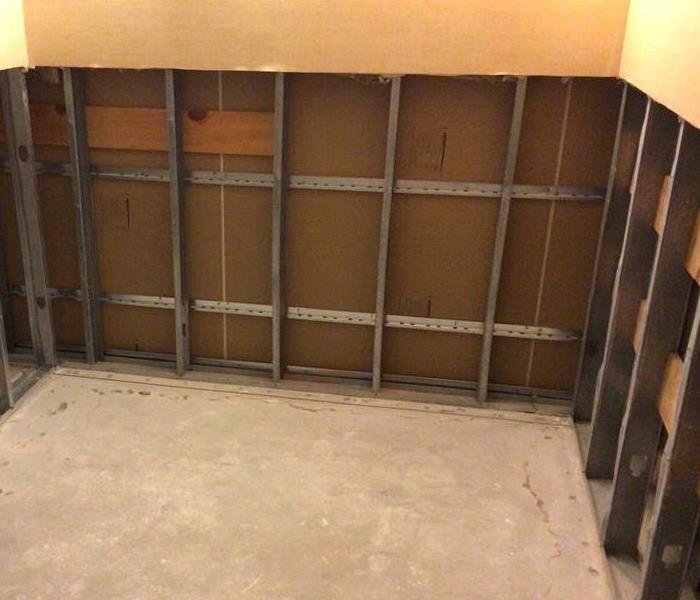 Give us a call for all your water damage needs. 518-677-3444
Give us a call for all your water damage needs. 518-677-3444
When your North Rensselaer/ South Washington County home experiences a water damage it can lead to many problems in your home, such as contamination or mold growth. If your drywall gets wet, you most likely will require a professional restoration company to come in and perform water restoration. If left wet or not dried out professionally wet drywall or other materials can lead to quick mold growth.
So, what is a flood cut? A flood cut is the process that involves cutting and removing of a section of drywall. Generally, the cut is usually 2 feet above the level where the water reached at its highest point. Flood cuts are not always necessary our main goal is to save your walls so if we are able to do so that is what we will try to do. However, if the water is contaminated and contains harmful pathogens then it must be removed for you and your family’s safety.
Flood cuts allow us to access the damage that was done. We are able to see the area behind the wall and see or remove other affected materials. They also improve drying. Once the section of the wall is removed, it allows the framing and other wood components that are hidden behind the wall to dry faster. The faster things are dried the less likely the chance of mold growth.
If you ever experience a water damage in your North Rensselaer/ South Washington County home, please do not hesitate to give us a call. We are IICRC certified in water restoration and have a team of highly trained professionals who are eager to help you and restore your home back to preloss conditions! We are open 24/7 to assist you at any time of the day so give us a call at (518) 677-3444!
Ice Dams Can Cause Water Damage in Your Bennington Count Vt. Home
4/5/2021 (Permalink)
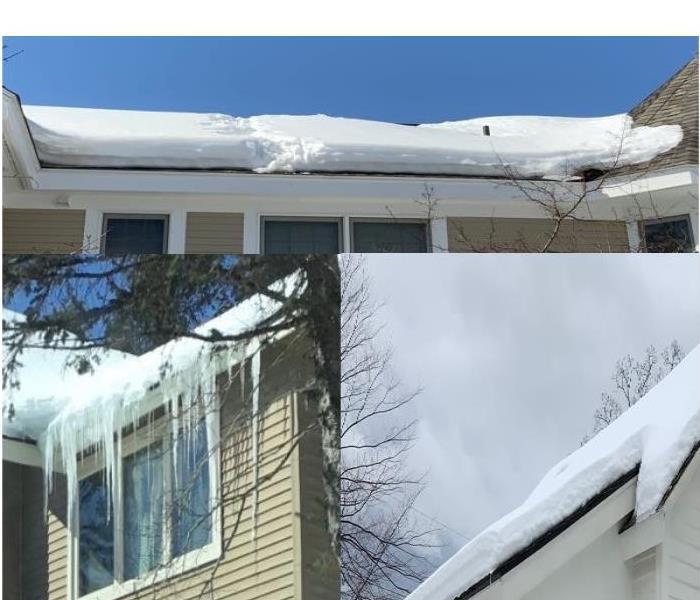 Give us a call if you have an ice dam that is making a mess inside your home. 802-375-1500
Give us a call if you have an ice dam that is making a mess inside your home. 802-375-1500
What is an ice dam you might ask? An ice dam is thick build ups of solid ice along the eaves of you roof. Ice dams are formed because heat builds up in your attic which warms your roof but does not warm your eaves. That snow then melts due to the warmth of the roof from the attic and then the snow freezes again once it reaches the cold eaves. And finally, the ice accumulates along the eaves and forms a dam. Then the meltwater from the warm roof begins to back up behind the ice dam and flow under the shingles in your home causing you to have a water damage.
We here at SERVPRO of Bennington and Rutland County have experience in remediating your home if you have been impacted by an ice dam. We have a team of trained professionals who are all certified in IICRC water and mitigation work. Our team along with our state-of-the-art equipment can make your home that has been affected "Like it never even happened." However, there are a few tips and tricks that can help you prevent ice dams forming all together!
- Use heated cables. These will allow you to equalize the heat on your roof.
- Use a fan box. Place a fan box and aim it at your roof where the leak is actively happening. Doing this will freeze the water and help stop the leak from continuing.
- Rake the snow from your roof using a roof rake!
- Adding more insulation to your attic floors to help keep the heat from rising.
- If your attic has an unsealed hatch cover it with weather stripped caps.
These are just a few helpful tips to prevent/ fix ice dams. If you have any further questions or have a water damage in your home or business, please call us at 802-375-1500!
Tips to Prevent Your Pipes From Freezing
3/9/2021 (Permalink)
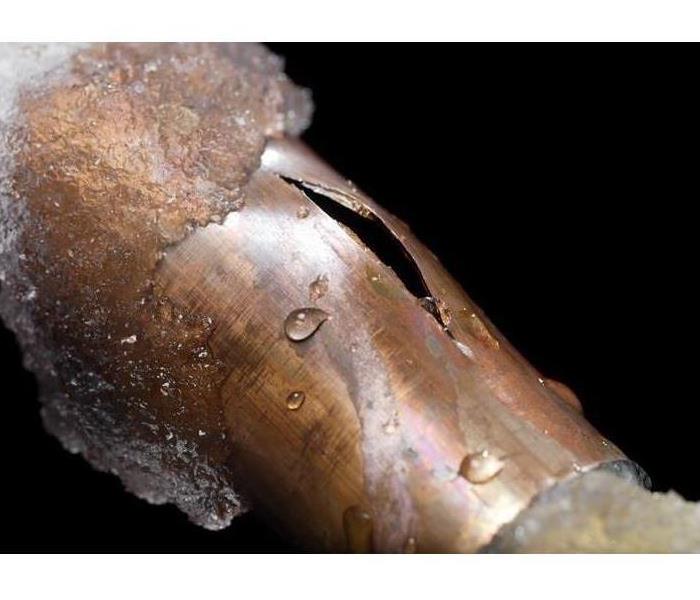 GIVE US A CALL 518-677-3444
GIVE US A CALL 518-677-3444
Winter is here, and with it, comes sub zero temperatures! Pipes freezing are a common occurrence that can happen in the winter. When pipes freeze, they expand your pipe to the point where it bursts! This is caused by the increase in pressure. Pipes bursting are a common cause of water damages that we here at SERVPRO of North Rensselaer/ South Washington Counties receive in the winter months. So here are some helpful tips to avoid frozen pipes and water damages that can happen from them!
- Maintain a consistent temperature throughout your home day and night.
- Keep your garage door closed to keep cold air out!
- Open interior doors to allow heat to circulate.
- If you are leaving your home for an extended period, leave your heat on and set the temperature to 55 degrees Fahrenheit.
- Insulate all exposed pipes properly.
- Let your faucet drip, moving water is less likely to freeze!
- Appy heat tape to pipes that are exposed.
If your pipes freeze at your home or business and you experience a water damage, please call us at 518-677-3444. No job is too big or too small and we here at SERVPRO of North Rensselaer/ South Washington Counties have the experience and the tools to help you with all you water damage needs!
What to Do When your Basement Floods
12/1/2020 (Permalink)
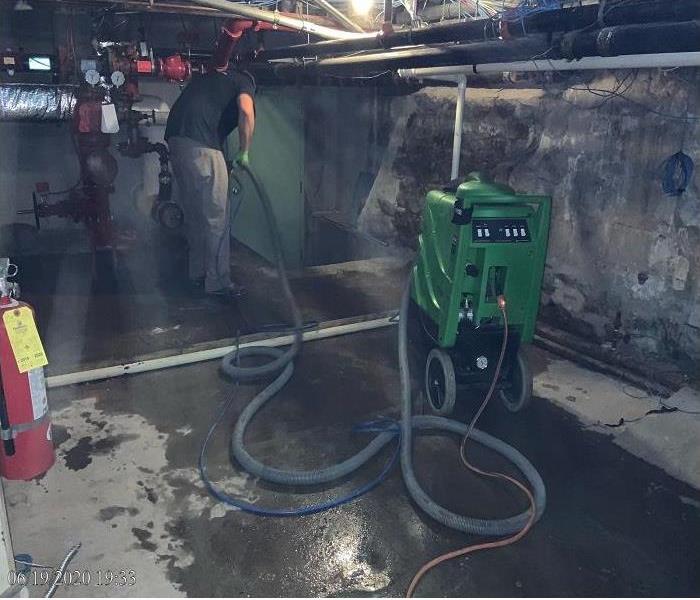 SERVPRO of North Rensselaer/South Washington Counties extracting water out of a customer's basement in Troy, NY
SERVPRO of North Rensselaer/South Washington Counties extracting water out of a customer's basement in Troy, NY
What to Do When Your Basement Floods
When a basement floods it is a stressful and confusing time. There are several different reasons basements can flood: a broken water pipe, heavy rainfall, or even a sump pump failure. Fortunately, here at SERVPRO of North Rensselaer/South Washington Counties we have been able to help families with flooded basements all around our local area and are ready to help you! Here are some important steps to take when dealing with a flooded basement:
- Turn off your electricity. This is the first step you want to take as soon as you can safely navigate to the breaker box. Appliances or wires may be in water so there is a good chance there is an electrical current traveling through standing water. This can be deadly! You would want to contact an electrician or electrical company if you are unable to turn it off safely.
- Find/Stop the source of the flood. If you discover the flood is plumbing related you will want to turn off your home's main water valve. If you discover it is rainwater that is flooding your home you will want to use sand bags or flood bags to create a barrier.
- Remove the water. You can use a shop vac, mopping, or blotting to do this depending on the severity. However, the more water you can pick up the better!
- Remove affected materials. You want to dispose of flooded carpeting or padding that is unsalvageable. Other porous items such as wooden furniture or sofas need drying as soon as possible to salvage them!
- Did you know that mold can start to develop within 24 hours of introduction to water? It is crucial to dry and disinfect the area properly in order to keep mold and bacteria from growing and spreading.
If your home suffers a water damage from a flooded basement, you want to check your insurance coverage to see what is covered. We here at SERVPRO of North Rensselaer/ South Washington Counties have years of experience and the resources to help with all your water damage needs. And we are prepared to get your home back to pre-flood conditions, “Like it never even happened.”
Steps to Take to Prevent Further Water Damage
8/12/2020 (Permalink)
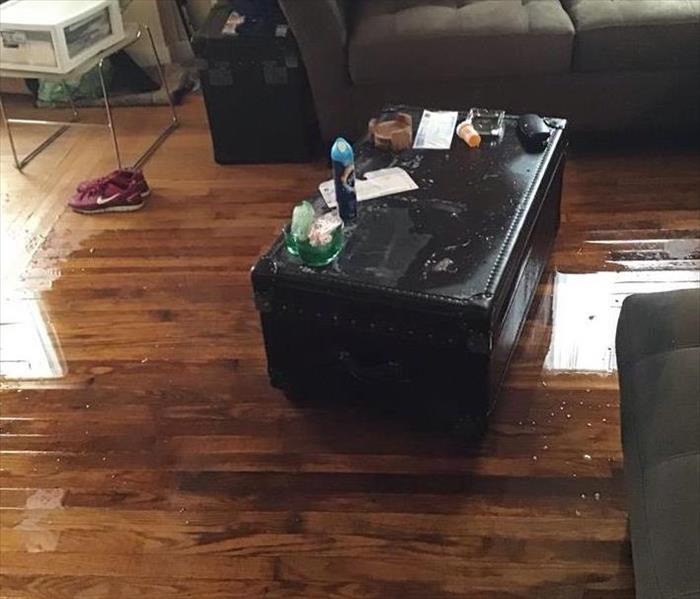 Standing water in living room of a recent water damage.
Standing water in living room of a recent water damage.
SERVPRO of North Rensselaer/South Washington Counties is here to help in the instance water comes into your home and causes damage.
Here are some steps to take to prevent further damage.
- The first thing you want to do is find out where the water is coming from. If the leak is not visible turn all water off at the main line. You also might want to check the roof for possible exposure.
- Second, get the towels, mop, and buckets out or whatever you can use to soak up as much water as possible. Now, if your basement if flooding, call SERVPRO, do not attempts to soak that water up because if electrical lines are affected you could get electrocuted. Be sure to also unplug any electronic devices that are around the leak to prevent power surge.
- Third, if furniture is sitting on wet flooring, especially carpet, use aluminum foil or wood blocks to go under the legs of the furniture from the flooring. This will prevent the legs of your furniture from soaking up any more water and prevent staining, and possible damage from the water to the furniture.
- After you have taken these steps, Call SERVPRO of North Rensselaer/South Washington Counties to come to the rescue. 518-677-3444
Affected Wood Floors
5/7/2020 (Permalink)
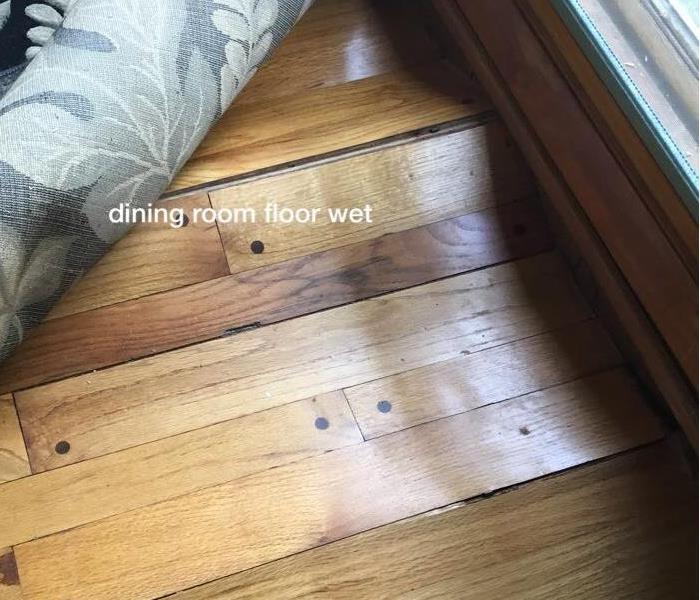 If you have wood floors and have had a water loss that has affected those wood floors, give us a call NOW! 518-677-3444
If you have wood floors and have had a water loss that has affected those wood floors, give us a call NOW! 518-677-3444
SERVPRO of North Rensselaer/South Washington Counties has responded to many water losses where wood floors have been affected. Wood floors differ from any other flooring material because there are so many different categories of wood floors. Wood Floors could be made of, bamboo, oak, pine, cherry, etc. Therefore, the drying process and salvation is different with every type of wood. Our technicians are trained to know the different processes needed to dry wood floor effectively. The first thing our technician will do is determine the type of wood they are dealing with and inspecting if it solid or an engineered wood product. Once the determination of which type of wood is completed, we then us a moisture meter to test the moisture levels in the floor. By taking these readings, it is the most effective way to determine the moisture levels. Meter reading also helps us understand how much water covered an area. For example, if the wood floor has increased by more 10% moisture content, the wood has swelled and is pushing the shouldering boards by ¾” or more. This will create large gaps when the floor is totally dried and back to original moisture content. If the floor has expanded and is actually buckling in areas, there might be the concern of whether or not the floor is salvable. If we have determine that the floors have a possibility on being saved, we at SERVPRO of North Rensselaer/South Washington Counties utilize a dry force system, which includes drying mats to dry the floor in place and relieve moisture within the wood floorboards. Unfortunately, not every wood floor can be saved. It is vitally important for us the restoration company to observe all the conditions involving wood floors beforehand and to understand how the wood floors were originally assembled. In some cases, wood floors have been in homes for years and removal can be trying. Therefore, when it comes to a water loss in your home affecting your wood flooring, timing is everything.
So, if you recently experienced a water loss and your wood floors are affected, please do not hesitate to contact us right away! We are trained professionals and are here to help in the restoration process of getting your hard wood floors back to their original condition.
518-677-3444
Building Materials that everyone needs to be careful with.
5/7/2020 (Permalink)
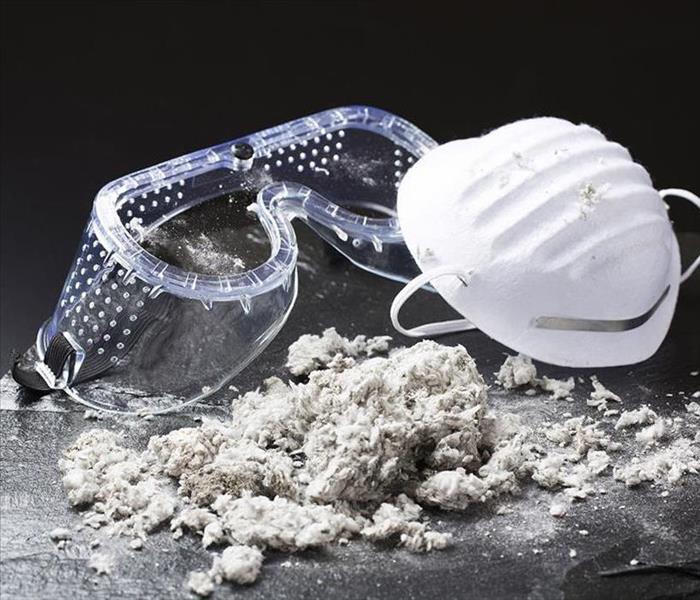 Always be safe when handling dangerous materials. Give us a Call to Remove them for you! 518-677-3444
Always be safe when handling dangerous materials. Give us a Call to Remove them for you! 518-677-3444
SERVPRO of North Rensselaer/South Washington Counties are trained in determining and properly reporting any hazardous building materials. The very first process of an initial inspection is to see what kind of building materials are affected and what potential hazards could be associated with the restoration process. Dangerous building materials include, Asbestos, Lead, Mercury, and Polychlorinated Biphenyls (PCBs).
Asbestos
Asbestos is a natural occurring fibrous mineral composed of thin, needle-like fibers. Asbestos is not banned in the united states and is resistant to heat, electricity and corrosion. High exposure to asbestos can lead to cancer and other health diseases including mesothelioma. Prior to 1986 asbestos was used in roofing materials, coatings, compounds, and plastics. You can also find asbestos in drywall, and floor tiles. Therefore, if SERVPRO were to receive a lead for a water loss in a home, the first thing we need to find out is what the year of the house is. The asbestos hazard emergency response act of 1986 highly regulates the mineral. For a home that was built prior to the 1980’s, regulation requires testing to be preformed and depending on the results of the test, will determine to actions that needs to happen in order to properly remove the hazardous material. In New York State, you must be certified in asbestos abatement to properly remove the hazardous materials. SERVPRO of North Rensselaer/South Washington Counties does NOT perform abatement, we seek out environmental companies that are in areas that we work. Environmental companies typically will perform the test and then handle the abatement if needed.
Lead
Lead is a heavy metal that was used in paints. Lead is not banned in the United States but was phased out in the 19th Century. Health risks associated with Lead is poisoning to the brain, kidneys and over exposure could lead to death. In 1970, lead paints were banned in the United States. At SERVPRO of North Rensselaer/South Washington Counties is trained and certified in lead testing, and abatement. Lead testing can be done in a lab by a licensed environmental company that uses x-ray equipment to detect lead in homes. This test can be very expensive and sometimes not worth the money because over the counter lead kits are usually performed and is said to have great outcomes. Depending on the results and affected materials, remediation of lead can be performed by SERVPRO of North Rensselaer/South Washington Counties.
If you or anyone you know may be hazardous materials lurking in your home or business and would like to get a quote of removing such materials- Give Us A Call Today! 518-677-3444
Pack Out with Success!
4/4/2020 (Permalink)
At SERVPRO of North Rensselaer / South Washington Counties, we take our customer’s personal property contents very seriously. We understand that there is nothing worse than having a flood or a fire come through a home and ruin everything in its path.
What are Contents?
A lot of people get confused when saying the word, “contents”. So, to put it in simpler terms, it is everything in a home that is not attached to the structure. Here are some examples of personal property contents:
- Clothing/Bedding
- Furniture
- Electronic
- Knickknacks
If a disaster strikes, what does SERVPRO of North Rensselaer / South Washington do to protect and restore a customer’s personal property contents?
Once a fire or a flood is stabilized, SERVPRO uses a state of art software program called Contents Track. The programs allow us to properly document items and determine what is unsalvageable and salvageable. Contents Track allows us to be efficient with content and manage all the items is a delicate manor. The very first step is to inventory everything. By taking photos of the damaged areas are really worth a thousand words and the only way to know exactly capture the damage and further update exactly what stage the restoration process is at. For example, if our crew is working on a master bedroom and there are multiple items to go through, first thing is we set up our boxes, and then tag those boxes with QR codes. The QR Codes are like bar codes and once the item is being packed is pictured, the items are scanned and the QR code tag is placed on the box. The code then transmits to the Contents Track software and saved. Once all contents are packed out, typically we move out all the items and bring them to a cleaning location where we can begin the restoration process. One by one each box that is full of contents are unpackaged and cleaned to restore back to its original state. Once cleaned a duplicate QR code is placed on a new clean box and is scanned then marked cleaned in the system. Now, we know this all seems like a long process as well as time consuming, but SERVPRO knows how important contents are to our clients, so we take pride in helping this process run smoothly.
If you have a water or fire disaster, please give us a CALL! 518-677-3444
Mitigation Vs. Remediation
3/22/2020 (Permalink)
SERVPRO of North Rensselaer South Washington Counties often gets asked the question, “What is the difference between Mitigation and Remediation?”. So, let us help you clear up a lot of your questions when it comes to a disaster that happens either in your home or business.
What is Mitigation?
The actual definition of Mitigation is the action of reducing the severity, seriousness, or painfulness of something. For example, if there was a water loss that happened, and an area was flooded and it had damaged your structure, SERVPRO of North Rensselaer South Washington Counties would mitigate the loss. This means we remove the effects materials and use drying equipment to help prevent any further damage in the coming future. I.e. Mold Growth.
What is Remediation?
Remediation is the act of remedying something, in reversing or stopping environmental damage. For example, if you have a lot of mold in an area, SERVPRO of North Rensselaer South Washington Counties will remove the mold and help prevent it from coming back by using industrial strength microbials and equipment to remediate the problem. Mold is a natural spore that can spread throughout an area, so it is best that the problem is dealt with at a professional level.
If you have any questions about the technical terms used in the restoration business, Give us a Call today! 518-677-3444
Water Loss- Categories and Classes
12/23/2019 (Permalink)
Water Loss- Categories and Classes
Water Losses in a home happen all the time whether the home has experienced damaging storms, pipe bursts, or even utility failure. Water Mitigation and Remediation companies like SERVPRO decipher water losses under categories’ and class. There are 3 categories when dealing with a water loss. The category is determined by the originating source and the level of contamination.
Category 1 (Cat1)
Cat 1 water loss means that the loss happened from a clean water supply and does not carry a risk if ingested or inhaled. Examples of a Cat 1 water loss included broken water supply lines and sink or tub overflow with no contaminants.
Category 2 (Cat2)
Cat 2 water loss means that the loss happened from a contaminated water source that has potential risk that is unsafe to ingest or even inhale. Examples of a Cat 2 water loss include overflows of washing machines, discharge from dishwashers, and overflows from toilet bowls.
Category 3 (Cat3)
Cat 3 water loss is the highest category with the most risk. Cat 3 water loss can contain pathogens, micro organisms and other harmful agents. Examples of a Cat3 water loss is sewage and outside driven weather condition that damage the home and disrupt its structure.
Water losses also carry a class depending on the amount of water and the anticipated rate of drying of wet materials. There are 4 classes to consider when there is a water loss.
Class 1 water loss may affect part of a room or minimal materials with the least amount of water and drying time.
Class 2 water loss may affect an entire room with a large amount of water and minor drying time.
Class 3 water loss may affect from above, such as ceilings, walls, and insulation with a greater amount of water and increasingly slow drying time.
Class 4 water loss is the highest class. This means that there is deep saturation and destruction of wet materials, usually hardwood floors, plaster, brick and concrete. This class requires long drying times and special methods including demolition.
Weighted Water Extraction!
8/15/2019 (Permalink)
Water extraction is extremely important in water remediation. When a water damage occurs in a home or a business, the first step in water mitigation is to remove all the water as quickly as possible! This will reduce the risk of water spreading into various areas into other rooms and reduce the damage.
Recently we serviced a home North of Albany where a supply line in a bathroom had broken and affected all three levels of the home! Immediately our crew was on the scene! We used a method of water extraction called “weighted extraction”. This technique is used to remove water from carpets and pads without having to remove the carpet! It allows us to save the carpet and in the end save on drying time! This method unfortunately cannot always be used. However, If contamination levels are low, then this is the best system to use. Still, if we are unable to use this method our expert team has other processes that we can use to extract water from your carpets and home!
We here at the SERVPRO of North Rensselaer/South Washington Counties are dedicated to responding immediately to you when you contact us! A quick response lessens the damage, limits further damage, and reduces the cost of these disasters. If your business or home experiences a water damage, please call us at (518) 677-3444 and our professional team will make it “Like it never even happened."
How To Build Containments
5/20/2019 (Permalink)
Containments are also referred to as critical barriers of plastic sheets that we put up around windows and doors. Our technicians may put up containment throughout your home for a couple of different reasons.
1. To isolate an area for drying
2. To minimize cross contamination from affected areas to unaffected areas
3. To confine dust and debris in a demo room or area.
Setting up a containment is a multi step process.
Step 1: Move and Protect Furniture
- Move furniture to the center of the room
- Cover with a plastic sheet to protect from dust/debris.
Step 2: Position AFD (air filtration device)
- An air filtration device is used to establish negative air pressure to contain contaminates and dust.
Step 3: Install Critical Barriers on Windows
- Use painters tape on painted areas
- Square up plastic to painters tape
- Secure plastic with duct tape
*DO NOT allow duct tape to touch the painted surfaces, as it will take off the paint
Step 4: Install Critical Barriers on Doors
- Door installation is the same as window with 1 extra step
- Cut a "T" flap in plastic panel: Place duct tape along the center and across the bottom resembling an upside down "T"
- Cut the center of the duct tape to create an open to go in and out of the containment.
- Place a 2nd sheet of plastic over the 1st sheet at the top of the door and secure with duct tape
- Allow 2nd sheet to freely open and close door
Step 5: Position Lay-Flat Ducting
- Connect ducting to AFD (air filtration device)
- Unroll to barrier where you will be exhausting, for example window barrier.
- Cut an “X” in the barrier and hold ducting up to the hole just cut
- Cut ducting about a foot beyond opening, so ducting extends about a foot outside
- Tie up a small amount of the end of the ducting to create back pressure which helps inflate ducting
Step 6: Turn on AFD
- Turn on AFD to a low or minimum speed
- Ducting should inflate
Step 7: Check Pressurization
- Visually see critical barriers pulling into contained area
- Use a manometer to meet the recommended -.02 pressure differential within the contained area
- Make adjustments to AFD speed and barriers, if needed
**DO NOT set AFD on high, this could cause barriers to collapse
Step 8: Complete Work
Step 9: Take down equipment once all testing is completed
Have Questions?
Call SERVPRO of North Rensselaer/South Washington Counties- (518)677-3444
Why Choose SERVPRO?
5/8/2019 (Permalink)
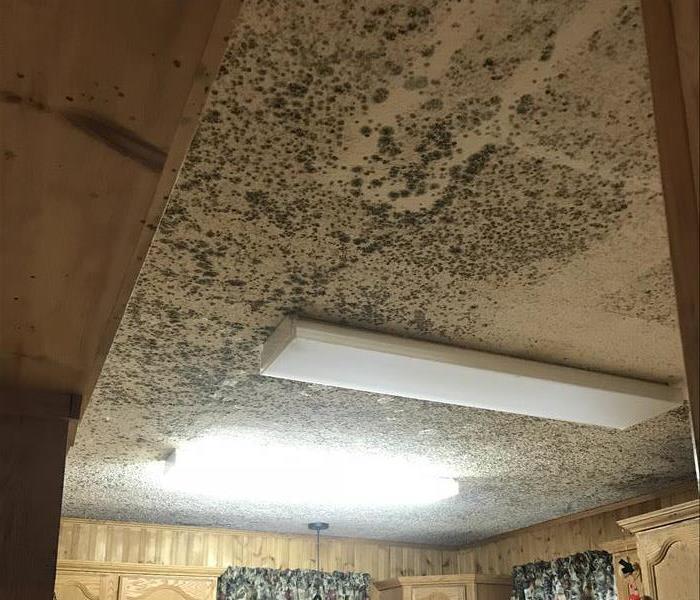 When water sits for a long period of time, it results in mold growth. We often see these types of losses in summer or vacation homes.
When water sits for a long period of time, it results in mold growth. We often see these types of losses in summer or vacation homes.
Many homeowners will suffer from water damage in their homes this spring. From flooded basements to broken pipes, SERVPRO of North Rensselaer/South Washington Counties is always here to help. Here are some reasons why you should call SERVPRO of North Rensselaer/South Washington Counties for your water restoration needs.
- IICRC Certified Firm
IICRC stands for the Institute of Inspection, Cleaning and Restoration Certification and is the driving force in establishing industry standards for water damage restoration. Our technicians are highly trained and equipped with the knowledge to restore your property. - Emergency Services
We understand that a disaster can happen any day of the week, any time of the day so SERVPRO of North Rensselaer/South Washington Counties offers emergency services 24/7. - Locally Owned and Operated
Our franchise is located in just over the NY-VT boarder in Cambridge, NY; centrally located between our territory of North Rensselaer and South Washington Counties. - Advanced Technology
The restoration industry is always changing with new equipment and/or techniques. SERVPRO of North Rensselaer/South Washington Counties stays up to date with the most advances equipment and uses a wide range of techniques. - Professional Mitigation Experience
Our technicians are not just in trained in water restoration, but mold remediation as well. Depending on how long the water sits, it could result in a mold problem. When you call SERVPRO of North Rensselaer/South Washington Counties, we provide professional mitigation services to properly dry the area and ensure you will not have mold growth in the future.
Call SERVPRO of North Rensselaer/South Washington Counties today at (518)677-3444 and we’ll make it “Like it never even happened.”
Causes of Water Damage
4/3/2019 (Permalink)
Water damage in a residential or commercial property is often caused by things like water leaking or flooding that goes unnoticed for a period of time. From minor repairs to carpet replacements, identifying water damage early is the key to minimizing potential damage to your home.
The ability to recognize and identify where the water is coming from and what is causing the damage is the first step. These are a list of the most common types of causes of water damages:
- Leaking, clogged, or bust pipes
- Malfunctioning air conditioners or other HVAC issues
- Leaking dishwashers, washing machines, or other household appliances
- Snow or ice buildup resulting in a leaking roof
- Natural disasters like hurricanes or rainstorms that cause flooding
- Overflowing toilet or bathtub
No matter what the water damage cause may be, having a plumber come out and address the problem immediately is crucial in reducing the amount of damage to your home. Once the cause has been fixed or at least contained, SERVPRO of North Rensselaer/South Washington Counties can come in and begin the water mitigation process. Call us our 24/7 emergency line at (518)677-3444 and we can help make it look” Like it never ever happened.”
Water Damage to Wood Floors
3/22/2019 (Permalink)
When a water loss, such as a burst pipe affects and saturates your hardwood wood floor, within a couple of days the floor can start to warp and the hardwood floor may completely need to be removed and replaced.
Once your hardwood floor suffers water damage, they immediately become saturated. The quicker this water is removed from the flooring the more likeliness it is the floors can be saved. The most common piece of equipment used to save wood flooring is called an injectidry.
An injectidry system is used to extract the water and moisture from an affected floor. Floor panels are placed on the affected floor and a hose is connected to the floors panels on one end and an injectidry system on the other end. This system creates to suction to lift up the water and moisture below the surface of the floor.
SERVPRO of North Rensselear/South Washington Counties has an on call 24/7 emergency response, so if you experience water damage to your wood floors, by calling us at (518)677-3444, you will have a greater chance of your floors being saved.
Determining Water Loss Categotries
1/3/2019 (Permalink)
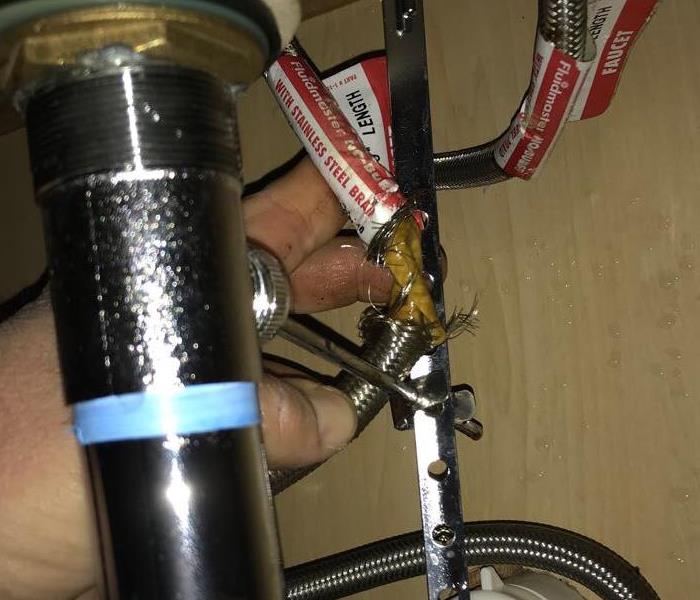 This broken hot water supply line is a good example of a Category 1 water loss.
This broken hot water supply line is a good example of a Category 1 water loss.
Water losses are categorized on three levels based on the range of contamination in the water.
Category 1: Water that originates from a sanitary source, such as a broken water supply line from a dishwasher and will not cause illness if inhaled or ingested.
Category 2: Water that originates from an unsanitary source, such as a broken aquarium and may cause discomfort or illness if ingested or contacted.
Category 3: Water that originates from an extremely unsanitary source, such as rising waters from a river or stream that can contain harmful agents if ingested.
- Because a water loss might originate from the source as a category 1, this could quickly change when the water travels, for example through a dirty carpet and the water can deteriorate to a category 2 or 3.
- The category could also deteriorate if the water sits for a period of time in the right climate, resulting in mold growth.
- It is very important that once the source of the water is determined (for example a broken pipe or overflowing washing machine), that it is fixed by a plumber before we begin our mitigation work as the homeowner does not want to problem to reoccur.
Contact the professionals at SERVPRO of North Rensselaer/South Washington Counties for our 24 hour emergency services at 518-677-3444 we will help make it “Like it never even happened.”
Layered Flooring
9/28/2018 (Permalink)
There were multiple layers of flooring in this home that had a severe water damage. Normally ceramic tile can be saved when drying a home, for the simple fact that it is a natural stone. We have extraction mats that lay over the stone and they remove any harbored water within and the wood subfloor beneath, since wood is also a natural material and will release water. Unfortunately, when this home was remodeled, they laid ceramic tile over top of vinyl flooring. Vinyl acts as a vapor barrier and will hold water between the ceramic tile and the subfloor. Since this layer existed, all of the tile had to be removed and the vinyl also had to be removed in order to dry the subfloor properly. Multiple layers of flooring like this can cause mold growth since it traps water within the layers. So when you remodel your home, remember it is worth the extra time to take out the old flooring first instead of laying over top.
Saving your carpet!
4/20/2018 (Permalink)
When you have water instrusion in your home, carpet is very time sensitive in order to save. Water extraction is needed as soon as possible and if the water is not extracted properly, and in this time frame, it may not be able to be saved due to delamination and bacteria growth. Our truck mounted system allows us to extract quickly and efficiently, removing 80% of the water from the carpet and carpet pad. After extraction we then set up drying equipment to dry the last 20% that cannot be extracted. We have another blog post that explains how other types of flooring handle being exposed to water intrusion and the steps to restore, if they are able to be restored. If you are in the remodeling process, and have questions on the durablity of your flooring options when it comes to water, you can always call our office at 518-677-3444. In the case of a water emergency, and you are in need of assistance, we are available 24/7 serving Granville to Troy.
How will your floors hold up against water damage?
2/19/2018 (Permalink)
Below are listed some different hard surface floorings, and how our SERVPRO team has experienced their reaction to water damage. Let's start with laminate flooring, one of the more common floors we see in homes today.
Laminate flooring is very resilient to almost anything except water. Laminate flooring advertises that it is real wood which is correct, but it only has a thin layer of wood on the top layer. The rest of the flooring is made up of particle board or press board. These types of materials absorb water very quickly and delaminate with minimal time. Imagine dog food when it absorbs water, it expands and breaks apart, that is the same with laminate flooring. Laminate flooring cannot be dried for that reason, but also due to the water that sits under the floor. Laminate flooring is a floating floor with a foam pad underneath. Once water has reached the pad you are unable to extract or evaporate the water. So, for both of these reasons, laminate flooring must be removed after a water loss, in order to dry out the structure and subfloor properly.
Vinyl is more resilient to water than laminate flooring, because it does not absorb water and is glued down not free floating. If a vinyl floor is affected by water damage, it can be saved depending on the amount of time the water has been dwelling. Once water has found its way underneath the tiles, the tiles must be removed. Vinyl acts as a vapor barrier and does not allow for evaporation which is needed in the drying process.
Linoleum: This type of flooring is much like vinyl when it comes to water damage. It is a vapor barrier and will need to be removed if water gets underneath, so the sub floor is able to dry.
Wood floor is a semi porous material that absorbs water slowly between the wood joints. If wood has been affected by a water damage, and is caught in a short amount of time, there are mats that can extract the water out of the wood and bring it back to its original state. If a wood floor has absorbed a significant amount of water and has dwelled for an extended period of time, then the wood floor will begin to cup and stain. If the floors are left in this condition it will get worse to the point of no return and must be removed. If wood floors are treated as soon as you see cupping, there is still a chance of them being saved. Water will get extracted, and then once dry, the wood can be sanded and refinished to get a smooth surface again.
Ceramic tile is the most resilient to water damage. It is semi porous like wood flooring, but is more apt to release water than wood. A large percentage of time, ceramic tile will dry, as well as the concrete or plywood underneath. The only time ceramic tiles need to be removed, is if the tiles and grout have loosened, or there is a plywood subfloor that is not drying. If the plywood will not dry, the ceramic tile will need to be removed to dry the plywood properly.
Please note all these processes of drying are within proper standards of dehumidification and air movement, performed by water restoration professionals. You will not get these results with at home equipment or leaving materials to air-dry.
Immediate steps to take when a water loss happens in your home!
2/1/2018 (Permalink)
The first thing you want to do is find out where the source of water is from, and shut off if possible.
Second, soak up as much access water as possible by mopping and using towels for any other surfaces. Cleaning up as much water as you can will prevent further damage.
Third, if furniture is sitting on affected flooring, especially carpet, use aluminum foil or wood blocks to separate the furniture from the flooring. This will prevent the legs of your furniture from soaking up any more water.
Lastly, move any contents or area rugs that may have been contacted by water, to prevent any futher damage.
Please note not to use any electronics that have been affected by water or are plugged in to an affected wall. This also regards any fixtures in the walls and ceilings.
After you have taken these steps, call your local SERVPRO. If you are located in North Rensselaer & South Washington Counties you can call our office at 518-677-3444.
Severe Water Damage
1/24/2018 (Permalink)
This winter has been a cold one!! These past couple months have been dangerous for many home owners. Why you may ask? These extreme temperatures and wind chill can freeze pipes in your home and create a water damage that can be catastrophic! This picture here was a home that was vacant due to being on the market. The water line to their tub froze and burst leaving water to run for days since no one was at the property, and the water froze on the outside of the home. The entire home had to be demoed due to the severe damage, but we were able to salvage the home and dry the structure.
What are some steps you can take to avoid a water loss in your home from these extreme cold temperatures? Make sure you have sufficient oil in reserve and keep your home much warmer than you normally would during these cold spells. You may feel you are saving money from keeping your heat low but in the long run you aren’t, especially for many with second homes that aren’t being lived in. One water damage can destroy your home and can be very costly to fix, so taking the necessary precautions are a necessity. Another great tip is to keep your faucets trickling while it is extremely cold. This keeps the water flowing so that the water will not freeze. For those problem areas that are hard to heat getting small electric space heaters can help to keep the pipes from freezing. One of the most important things to do to your home to protect from frozen pipes is during the summer month to check your insulation and see if there are areas that you can insulate that can protect from any draft or unwanted cold air getting to any of your water lines. These ideas may be basic but by following these tips you can prevent a water damage in your home. If you follow all of these tips and you still experience a water loss, there is no need to worry because we are here to salvage and dry out your home and make it "Like it never even happened."
Drying Time after a Water Damage
11/11/2016 (Permalink)
If you are wondering how long it will take for your home to dry after a water damage, it is hard to pinpoint an exact amount of time without knowing the materials of your home’s structure, or the amount of water damage. We can tell you that through our experience, we have found that after non-restorable materials have been removed, drying on average is about 3-4 days. This time frame only correlates with the placement of the required commercial air movers and dehumidifiers from the calculation of many variables including temperature, humidity, and square footage. You will not have these results with at home equipment or if you were to let the structure air dry. It is important after a water damage to consult a water mitigation specialist, as improper drying techniques can lead to mold damage. If you ever need us we are available 24/7. Call SERVPRO of North Rensselaer and South Washington Counties at 518-677-3444.
How different floorings react to water damage
10/17/2016 (Permalink)
Below are listed some different hard surface floorings, and how our SERVPRO team has experienced their reaction to water damage. Let's start with laminate flooring, one of the more common floors we see in homes today.
Laminate flooring is very resilient to almost anything except water. Laminate flooring advertises that it is real wood which is correct, but it only has a thin layer of wood on the top layer. The rest of the flooring is made up of particle board or press board. These types of materials absorb water very quickly and delaminate with minimal time. Imagine dog food when it absorbs water, it expands and breaks apart, that is the same with laminate flooring. Laminate flooring cannot be dried for that reason, but also due to the water that sits under the floor. Laminate flooring is a floating floor with a foam pad underneath. Once water has reached the pad you are unable to extract or evaporate the water. So, for both of these reasons, laminate flooring must be removed after a water loss, in order to dry out the structure and subfloor properly.
Vinyl is more resilient to water than laminate flooring, because it does not absorb water and is glued down not free floating. If a vinyl floor is affected by water damage, it can be saved depending on the amount of time the water has been dwelling. Once water has found its way underneath the tiles, the tiles must be removed. Vinyl acts as a vapor barrier and does not allow for evaporation which is needed in the drying process.
Linoleum: This type of flooring is much like vinyl when it comes to water damage. It is a vapor barrier and will need to be removed if water gets underneath, so the sub floor is able to dry.
Wood floor is a semi porous material that absorbs water slowly between the wood joints. If wood has been affected by a water damage, and is caught in a short amount of time, there are mats that can extract the water out of the wood and bring it back to its original state. If a wood floor has absorbed a significant amount of water and has dwelled for an extended period of time, then the wood floor will begin to cup and stain. If the floors are left in this condition it will get worse to the point of no return and must be removed. If wood floors are treated as soon as you see cupping, there is still a chance of them being saved. Water will get extracted, and then once dry, the wood can be sanded and refinished to get a smooth surface again.
Ceramic tile is the most resilient to water damage. It is semi porous like wood flooring, but is more apt to release water than wood. A large percentage of time, ceramic tile will dry, as well as the concrete or plywood underneath. The only time ceramic tiles need to be removed, is if the tiles and grout have loosened, or there is a plywood subfloor that is not drying. If the plywood will not dry, the ceramic tile will need to be removed to dry the plywood properly.
Please note all these processes of drying are within proper standards of dehumidification and air movement, performed by water restoration professionals. You will not get these results with at home equipment or leaving materials to air-dry.
How does SERVPRO know what is wet in my home?
8/18/2016 (Permalink)
Have you ever wondered how SERVPRO detects what parts of your home are wet and how they can tell where the water has traveled?
To do this, we use a Protimeter .They are Moisture Sensors, Moisture Meters, and Thermohygrometers all in one. Each part tells us a little bit of different information.
- The moisture sensor detects where there is water.
- The moisture meter tells us the moisture content of various materials. Most materials such as drywall and concrete read in points ranging from 001-999, but wood material is calculated by percentage from 0% to 100%. With these readings we can see where the water traveled and also helps us when we are monitoring to show that the materials are drying.
- The thermohygrometer tells us the temperature and the humidity in the room. Capturing these two readings calculates specific humidity, dew point and vapor pressure, which leads us to calculate the amount of fans and dehumidifiers needed to dry the area.
First steps to take immediately after a water loss!
8/17/2016 (Permalink)
The first thing you want to do is find out where the source of water is from, and shut off if possible.
Second, soak up as much access water as possible by mopping and using towels for any other surfaces. Cleaning up as much water as you can will prevent further damage.
Third, if furniture is sitting on affected flooring, especially carpet, use aluminum foil or wood blocks to separate the furniture from the flooring. This will prevent the legs of your furniture from soaking up any more water.
Lastly, move any contents or area rugs that may have been contacted by water, to prevent any futher damage.
Please note not to use any electronics that have been affected by water or are plugged in to an affected wall. This also regards any fixtures in the walls and ceilings.
After you have taken these steps, call your local SERVPRO. If you are located in North Rensselaer & South Washington Counties you can call our office at 518-677-3444.
The science behind drying your home or business is....
4/20/2016 (Permalink)
Psychrometrics. Psychrometry is the study of the air and its properties. The properties of temperature, humidity, vapor pressure and dew point are measured to evaluate air conditions in the structure, enabling a SERVPRO Professional to create the proper atmosphere for more efficient drying.
Water can damage materials in two ways. First, materials absorb water through direct contact. Second, materials absorb water from the air. Measuring the moisture content of the air is critical to the drying process.
We as restoration professionals must establish an environment favorable for drying. It is critical we also understand how to manipulate temperature and humidity levels to produce optimum drying conditions without causing secondary damages through improper drying processes. The tools and equipment used to achieve the proper drying environment are: Moisture Sensors, Moisture Meters, Thermo-hygrometers, Infrared Cameras, Manometers, Air Movers, and most importantly our Refrigerant and Desiccant Dehumidifiers.
This is a little hint of what we do to make it "Like It Never Even Happened"






 24/7 Emergency Service
24/7 Emergency Service












